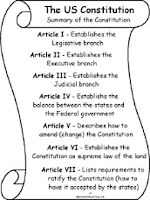THE ARTICLES!
-
Article I – The Legislative Branch. The principal mission of the legislative body is to make laws. It is split into two different chambers – the House of Representatives and the Senate. Congress is a legislative body that holds the power to draft and pass legislation, borrow money for the nation, declare war and raise a military. It also has the power to check and balance the other two federal branches.
-
Article II – The Executive Branch. This branch of the government manages the day-to-day operations of government through various federal departments and agencies, such as the Department of Treasury. At the head of this branch is the nationally elected President of the United States.The president swears an oath to ‘faithfully execute’ the responsibilities as president and to ‘preserve, protect and defend the Constitution of the United States’. Its powers include making treaties with other nations, appointing federal judges, department heads and Ambassadors, and determining how to best run the country and run military operations.
-
Article III – The Judicial Branch. Article III outlines the powers of the federal court system. Determines that the court of last resort is the US Supreme Court and that the US Congress has the power to determine the size and scope of those courts below it. All judges are appointed for life unless they resign due to bad behaviour. Those facing charges are to be tried and judged by a jury of their peers.
-
Article IV – The States. This article defines the relationship between the states and the federal government. The federal government guarantees a republican form of government in each state, protects the nation and the people from foreign or domestic violence, and determines how new states can join the Union. It also suggests that all the states are equal to each other and should respect each other’s laws and the judicial decisions made by other state court systems.
-
Article V – Amendment. Future generations can amend the Constitution if the society so requires it. Both the states and Congress have the power to initiate the amendment process.
-
Article VI – Debts, Supremacy, Oaths. Article VI determines that the US Constitution, and all laws made from it are the ‘supreme Law of the Land’, and all officials, whether members of the state legislatures, Congress, judiciary or the Executive have to swear an oath to the Constitution.
-
Article VII – Ratification. This article details all those people who signed the Constitution, representing the original 13 states.
As seen in each one of the articles each group has it's own responsibilities. Article I, those included are the Senate and House of Representatives. Together they make the laws. Article II; the President. He has the say so of what happens on a day to day basis. Article III this includes your judges and court systems. They enforce the laws. Article IV; states. Each state has different set of rules but the states also work with the federal system. Article V if you want something changed in the constitution add an amendment! Article VI; everyone should obey what the Constitution says. IT IS LAW! Finally Article VII, simply as it says "ratification" how each state should ratify law.

No comments:
Post a Comment